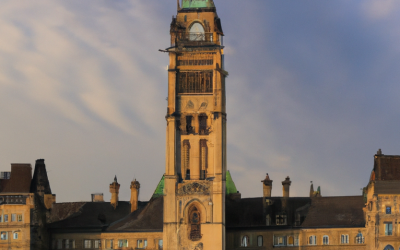In a line at the supermarket checkout, I glanced back at the woman who was placing her purchases on the belt behind my grocery items, and I couldn’t help but wonder what life had done to her to put such an expression of tired crabbiness on her face. That unpleasant expression, mixed with an obvious impatience at the slowness of the line, certainly didn’t make her face a pleasant one to look at, and I had no reason to glance her way again until the checkout person — a young man with an earring — shared a joke with the shopper he was ringing in, and I heard a burst of laughter from behind me.
Turning, I saw a completely different woman, her face transformed by a cheerful smile as she looked up at me and said, “If he liked that joke, just wait till he sees my credit card.”
The transformation was amazing, almost miraculous. Suddenly the woman with the pinched and crabby expression was someone with whom I felt I could chat, discuss the strange jump in the price of broccoli, and share a mischievous grin when the young man with the earring said to the elderly male shopper ahead of us, “Do you want a hand with your bag?”
I paid for my purchases, said good-bye to the now quite cheerful woman, and, as I walked out to my car, I thought about the way her smile had changed her appearance so dramatically and opened up communication between us. Driving out of the parking lot, I saw the woman emerging from the store, and she actually recognized me behind the wheel, because she gave me a cheery wave.
Driving home, I thought some more about how transformative a smile can be, how it makes communication far more likely, how it makes one feel more generous and caring about someone who would normally not prompt such feelings. And then I began thinking about how few are the smiles of cordiality and genuine friendliness that appear on the faces of Indigenous leaders, how rarely one hears the verbal equivalent of a smile — words of conciliation, friendship or praise from the lips of those who supposedly seek a new relationship with non-Indigenous Canada. Is it wise, I wondered, to maintain an attitude of accusation, blame and complaint when a smile would achieve so much more?
I’m sure many would argue that, with so many serious concerns and suspicions of “white” apathy or oppression, native leaders can hardly adopt a genial attitude when dealing with the oppressors, or — heaven forbid — indicate any pride in being Canadian. The chances of the AFN Head Chief being seen in public with an “I Love Canada” shopping bag of the sort sold by Loblaws are very slim indeed. But think of how much goodwill such a gesture would create.
When one thinks of Nelson Mandela, arguably the most successful leader of an oppressed people in the last 100 years, one does not think of a man who was always scowling, always hurling charges of this and that against the white population of South Africa. Much of Mandela’s credibility and authority — and his eventual success — came from the fact that he was able to fight for justice without rancour or vindictiveness. That genial smile of his seemed to show a man who had moved beyond all that — a man who in his openness to others and his focus on the ultimate goal was able to achieve what many had thought impossible, the elimination of apartheid and a freeing of his people. In that, Mandela was truly wise.
North American Indigenous elders are, almost by definition, assumed to be wise. The image of native elders guiding the tribe through difficult times, giving sensible advice about contentious matters, perhaps restraining hotheaded young braves who itched to go on the warpath, is solidly implanted in many minds, not all of them Indigenous.
And in days gone by, native elders did indeed have a great deal of what could reasonably be called wisdom. If they reached old age, those men and women had years of experience to draw upon, and years of contemplation to make sense of it all. No better source of cautionary words and sound advice was available to people whose lack of a written language prevented them from transmitting to a new generation what had been experienced in the past, and what had been learned from that experience. The generally positive results of listening to the elders’ advice earned them respect, even veneration. It was often believed that the elders received their obviously beneficial wisdom from the spirit world.
But no spiritual link is necessary to explain the wisdom of native elders. Put in simple terms, the fact that they had lived longer, seen more, passed on the words of previous elders, and thought about things longer, made them the wise men and women of the tribe. And there were times when long experience told them that sometimes it is better to extend a hand of friendship than raise a war lance or notch an arrow.
One often sees references to the importance of wise native elders providing guidance to their tribes in days gone by, and even today one might find a native leader referring to his or her consultation with tribal elders. But for the most part, the elderly men and women living on the Blood Reserve in southern Alberta or the Peguis First Nations Reserve in Manitoba are not the ones making policy, sending out messages via the Internet, speaking to the media, and sitting down with provincial and federal ministers to hammer out important agreements.
The individuals who do those things today are politicians, not wise elders, and they speak, act and negotiate like politicians, their main goal being immediate advantage, not the pursuit of longer-term goals dictated by wisdom. Elected chiefs say and do the things that they believe will please their constituents, which is to say, the people whose votes will keep them in their present office. It’s as if the revered Blackfoot chief Crowfoot sensed that his people wanted to join the Riel Rebellion and proudly announced his tribe’s intention to support that ill-fated uprising. His refusal to involve his tribe was at the time criticized as cowardice, but today Crowfoot’s decision is usually mentioned when references are made to his wise leadership.
We live now in a time when wise leadership might very well lead to real change and what is being called “reconciliation.” But are the current strategies employed by native leaders the wisest approach?
I once had a very good conversation with my father, during the course of which I argue heatedly for a particular social program that I thought was a very good idea. My father listened patiently as I outlined my reasons for thinking so, and then he said to me, “You can have all the good ideas you want, but if you can’t get people to accept them, you had better think again.”
And that is the point of this essay. Native leaders, activists and their supporters seem totally blind to the fact that their demands, their often hostile declarations, combined with repeated accusations and complaints, simply do not wash with the Canadians who really count: the voters. Whether the voters are ill-informed or self-absorbed or racist is beside the point. They are a reality that wise Indigenous leaders would recognize and consider when formulating policy or making arguments. Winning over the majority of Canadian voters will not be easy, but continually making strident accusations, claims and demands is hardly the way to do it. And voters connect more with people who seem to be friendly and “one of them.”
It would be hard for a genuinely concerned native leader to pull back from policies or strategies that demand action on poverty, lack of education, and other challenges that today face tribal members, but is aggressively pressing for immediate remedy of all those problems while hurling accusations of racism and colonial oppression the wise course? Do confrontational stances on issues like pipeline expansion suggest wisdom? Is creating a greater divide between Indigenous and non-Indigenous Canadians likely to benefit their people in the long run?
My father’s words come back to me now as I consider the question of what constitutes wise leadership. I haven’t yet read Amanda Sussman’s well-received book, The Art of the Possible: A Guide to Political Activism, but one review of it mentions its “constant cautions to lower expectations and learn how to compromise.” And I assume this is what responsible members of government learn. The Prime Minister and his Cabinet know that there are children in Canada today who suffer from malnutrition or a lack of medical care, but few Canadians would expect Ottawa to simply pour billions of dollars into a fund that would feed every child properly or provide doctors and nurses in every tiny community. Providing immediate assistance for some disadvantaged segments of our population cannot come before attention to wider national concerns, an attention that makes things better in the long run, and experience tells us that providing lots of short-term funding is rarely the best way to ensure a healthy economy and long-term prosperity for all.
When Election Day rolls around, Canadian voters may vote for the party that seems to offer the most short-term benefits, but they do so in the belief that the men and women they send to Ottawa will not bankrupt the country in providing them. And federal politicians once elected — for whatever reasons — usually take the long-term approach, which explains why elections promises, if kept, are so often watered-down, and why Canada has always been seen as a fairly moderate country. And a relatively happy and prosperous one at that.
While CBC Radio guests and contributors to the Globe and Mail may appear totally on board with the arguments being made for Indigenous self-government, a re-working of the nation’s legal system, power to halt industrial development, a re-naming of buildings and streets, and a banishing to purgatory of anyone suspected of cultural appropriation or racial denigration, the average Canadian voters will simply not accept significant changes to a society they know and have faith in. This non-Indigenous Canadian will presumably be called arrogant for urging Indigenous leaders to abandon or at least modify their current approach, lest they find themselves dealing with a federal government that is far less concerned about native issues, and far more intransigent when it comes to negotiating treaties or land ownership.
I believe wise native leaders would see the likelihood of such a thing and plan accordingly, just as Crowfoot, described by historian Hugh Dempsey as “a wise and farsighted chief”, looked beyond immediate advantage and discouraged the traditional stealing of horses from the Crees. Dempsey writes that “From this first meeting [in 1874], there was a feeling of friendship and trust between Crowfoot and [NWMP Colonel James] Macleod,” a relationship that proved of great benefit to the Blackfoot.
Some would say that only by constantly pressing for change, constantly attacking the status quo, constantly pointing to past injustices, will Indigenous people emerge from the second-class citizenship to which they now seem condemned. But the manner in which that pressure is exerted counts for a great deal. Those old enough to remember the 1960s will recall that not every protest against the Vietnam War or racial discrimination was peaceful, persuasive, and positive in its results. The Black Panthers and the Weather Underground remind us that extreme positions often hurt the cause for which people are fighting. An environmental protest that turns violent may demonstrate the passion of the protestors for their cause, but it may also confirm people’s beliefs that environmentalists are nothing but a bunch of anti-social nutcases.
Politicians of any stripe put forward policies and make public statements for a host of reasons, one of them a firm belief that the path they are taking will benefit their constituents. But that belief may or may not be sound, as we see with provincial politicians who mistakenly think fighting with Ottawa will benefit their province. Still another reason for the adoption of certain positions and the making of bold public statements is to gain support and short-term advantage for their political party, and a good many Canadians see this in the way some Indigenous leaders are behaving. With each deeply partisan demand, Canada’s Indigenous people are being turned into a political party, increasing division within the country.
And of course, politicians are not saints. Many act out of pure self-interest, attempting to solidify or increase their own personal power and prestige. When nearly every online media release from the Assembly of First Nations begins with the words “AFN Head Chief Perry Bellegarde…”, one tends to regard the statements that follow with a jaundiced eye.
This is not wise leadership. Some would say it is pure folly. But it doesn’t have to be this way.
If I may quote Nobel Peace Prize recipient Mother Teresa, “We shall never know all the good that a simple smile can do.”



